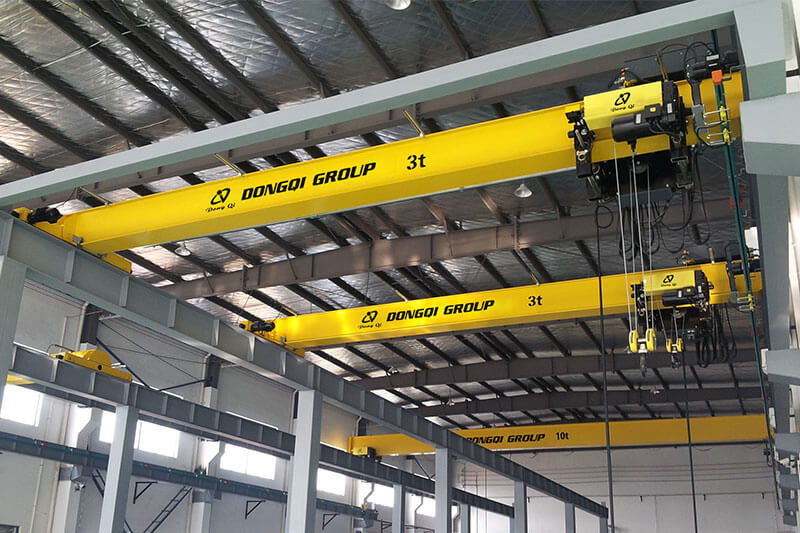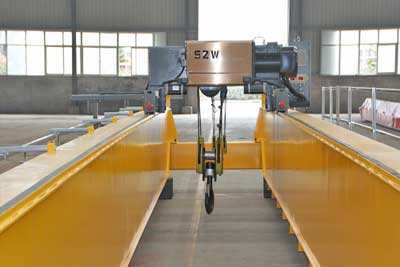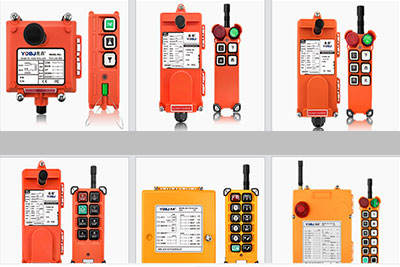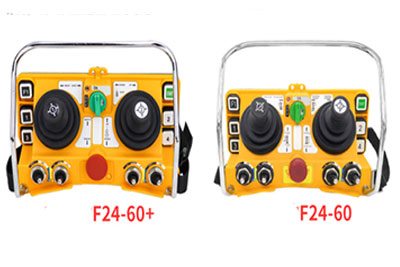Remote Control Overhead Cranes & Wireless Remote Operated Cranes
Remote control overhead cranes & gantry cranes to improve your safety & efficiency.Check How remote operated crane benefit you business and How to select remote bridge crane for your use.Now.
Remote control overhead crane , remoted operarted crane much safer & easier
A remote control overhead crane is one of the most regularly utilized material handling equipment in various industrial sectors, such as steel , machinery, and general manufacturing, etc. As one type of remote controlled crane, which is a crane controlled by an operator not in a pulpit or in the cab attached to the crane, by any method other than pendant or rope control, according to OSHA. The remote control cranes provides high safe, efficinecy, since the operator holds a wireless transmitter and keeps a specific distance away from the loads, such as 30 meters.
Nowadays, the remote control overhead cranes are with increasing popularity due to its advantages of high productivity and safety. To meet various industrial settings and lifting requirements, the remote operated cranes can be designed into Overhead bridge cranes , Gantry cranes, Jib crane, Single girder crane, Double girder crane, Top running crane, and under-slung cranes, etc. Customized remote control overhead cranes are available, please feel free to contact us if you have any needs.
Overhead crane remote control is generally preferred for a wide range of applications to keep the crane operator safe, so it is sometimes a better alternative for pendant operated crane in terms of safety protection. However, in some applications, when it comes to a higher requirement for the lifting capacity and working environment, particularly for transporting large and heavy loads through a long distance or in a hazardous working environment such as steel mills, the cab operated crane is absolutely the first choice.
Remote operated crane for sale
In terms of crane operation or crane control techniques, we have remote control overhead crane, pendant operated crane, and cab operated crane for sale, as well as single girder overhead crane and double girder overhead crane, gantry cranes, and jib crane in terms of crane structures and crane designs. The crane control method has evolved dramatically as a result of technological advancements including crane safety and operational upgrades. Nowadays, a considerable number of overhead cranes use remote control as a standard arrangement, which provides numerous benefits for crane users and operators.
The pricing of remote operated overhead cranes vary depending on their configuration. We offer a wide range of electric overhead travelling cranes for a variety of uses and applications. If you want to buy an overhead eot crane, please tell us your specific needs, and we will supply the suitable material handling equipment or customized solution for you at cost-effective price.

Single Girder Remote Control Overhead Crane
Single girder remote control crane parameters:
- Load capacity: 1-20t
- Span: 7.5-28.5m
- Lifting height: 6-18m
- Lifting speed: 0.8/5m/min
- Hoist running speed: 2-20m/min
- Crane running speed: 3-30m/min
- Work duty: A5

Double Girder Remote Control Overhead Crane
Double girder remote control crane parameters:
- Load capacity: 5-80t
- Span: 10.5-31.5m
- Lifting height: 6-18m
- Lifting speed: 0.4-5m/min
- Trolley running speed: 2-20m/min
- Crane running speed: 3-30m/min
- Work duty: A5
Remote Controller for overhead cranes
A remote control system for overhead cranes is made up of a portable transmitter unit that sends control signals and reception equipment that is permanently installed on the eot crane and electrically coupled to the crane's motor controllers. All the functions and operations of the remote overhead cranes are controlled by turning on the transmitter. They can be installed on an existing crane as a retrofit or as part of a new construction project.
Each switch on the remote controller generates a distinct set of pulses that are sent to the crane-mounted receiver via radio signal or infrared beam. To activate the desired motor controllers, the pulse strings are stripped from the carrier signal at the crane. For all practical purposes, the response time of the electronics is instantaneous.
The receiving equipment cabinet contains electronics for decoding the controller's radio signal, as well as drivers that extract the pulse codes from the incoming signal and convert them into signals suitable for the crane's motor controllers.
The encode/decode techniques are solely responsible for the correctness and dependability of remote controller functioning. Only the correct signal (radio frequency or light beam) will be received and decoded, as well as an identifiable pulse code format. The circuits are also built to protect against interference and unintended code creation.


Remote control crane operation: Easier, Safer & Higher efficiency
Overhead Cranes play an important role in a variety of industries, including aircraft/aerospace, automobile manufacture, chemicals and minerals, pulp and paper, steel production, and utilities, as well as the grain industry, logging, rail yards, and ship loading.
Human operators have always operated industrial cranes from cabs inside the cranes. In such cases, the operator's movements are guided by hand signals from someone outside the crane.In other circumstances, rather than having an operator seated in a cab, the unit might be operated by a person standing outside the crane, utilizing pendant pushbutton stations dangling from the crane. Compared with the pendant operated cranes & cab operated cranes, the remote control eot crane system has the following benefits:
Improved safety
Improved safety is one advantage of remote control operation. That is, no one needs to be physically close to the crane and its operation and risk being struck by the crane or its load. There is also no need for a human operator within the crane cab, who could be wounded as well. While an operator in a cab is less likely to be injured than someone outside of the cab, cab operators are nonetheless susceptible to ergonomic injuries (neck, lower back, arm, hand, etc.) as a result of continual bending and control panel manipulation. Another issue that cab drivers face is fatigue.
When switching from a pendant system to a remote control system, safety is greatly improved. The use of a wireless crane remote control system to manage the crane rather via pendant or cab controls is one safety measure that is now extensively used.
Enhance Safety with Crane Remote Control in the following 3 ways:
- Reduce the possibility of falling material or dropped loads.
- Reducing the possibility of human error.
- Identifying potential trip hazards and pinch spots.
Crane operated by remote control system reduces the possibility of falling material or dropped loads.
There is an increased danger of accidents due to falling materials unless the operator can be safely positioned away from the weight. Additional elements contributing to this risk include a reduced line of sight to the weight, trip/slip hazards, mechanical failure, and operator competency. The operator is no longer linked to the pendant and thus the crane when utilizing a remote control system, allowing the operator to place themself out of the danger zone, away from the hoist and its weight.
In comparison to the fixed pendant's field of view, the remote control crane provides wider visibility and an enlarged line of sight to other operations and workers on the ground. This allows operators to avoid or alert other members of the work crew to an imminent hazard and prevent it from occurring.
Crane remote control technologies are intended to eliminate human mistake.
One of the most important considerations in reducing accidents is ensuring that overhead crane equipment is operated by qualified personnel. Having the right certification and training on the equipment boosts the operator's capacity to avert an accident significantly. Modern wireless remote controls include built-in safety measures that enhance the operators' expertise, adding another layer of prevention to the safety strategy. Standard crane remote control systems contain the following safety features:
- Ergonomic design to avoid accidental operations.
- Machine stop switch is simple to use and secure.
- Using push-to-operate buttons and bars or double-jog-enable features, barring illogical combinations, and imposing interlocks and limits on particular function combinations, unexpected motions can be avoided.
- Feedback and signals via haptic (vibration), LED, and LCD.
- Close Start RF and Infrared, RF Range Limiting, and Infrared Zoning.
- Supervisory roles and key interlocks.
Crane remote control systems allow the operator to instantly identify trip hazards and pinch points.
Crane remote control devices provide crane operators with greater mobility and a clearer line of sight. These two criteria make identifying possible tripping hazards and pinch points easier for operators. Because they are no longer linked to the crane, operators can move at their own pace rather than the crane's.Furthermore, operators are no longer restricted by the pendant's range of movement, allowing them to position themselves at a better vantage point with an improved line of sight, allowing them to plan their movements and reducing the likelihood of tripping/slipping and crush points during crane operation.
Fortunately, organizations and operators have implemented a wide range of safety precautions to keep crane users safe while also preserving the critical use of cranes in these industries. Crane remote controls give another degree of security and will be utilized by crane operators for many years.
Improved efficiency
Another advantage of remote control technology is increased efficiency when implemented on the correct cranes. That example, while remote control crane technology has numerous advantages, it is not always essential or acceptable. This is mostly determined by how frequently the crane is used. Cranes that run 90% or 100% of the time benefit from cab-mounted operators. Cranes that are only used a few of times per day, on the other hand, are probably best operated by cab-mounted operators, not because of any human efficiency, but because the expenditures associated with obtaining and installing remote control equipment are likely not justified.
Cranes that are operational 20 to 80 percent of the time are the most likely candidates for remote control technology, as this is where the greatest efficiencies of the technology will be realized. The reason for this is that one of the people who would normally be involved in the crane operation - either the cab operator or the outside "spotter" - can be assigned to do something else.
When switching from a cab operator setup to a remote control system, efficiency improves significantly. "With radio controlled technology, you can give the guy on the ground complete control."This allows the corporation to reassign the crane operator to a more relevant position." Furthermore, remote control units enable cranes to function more quickly, allowing for more work to be completed in less time than when units are managed by cab operators.
How to choose a right remote wireless control for your application?
Remote crane control may not be for every situation; the following key areas need to be evaluated.
- Remote crane control may not be appropriate in all situations; the following major aspects must be considered.
- Duty cycle: Cranes that are in operation 20% to 80% of the time are inefficient since the cab operator is idle for the most of his shift. When the crane is not in use, the worker on the floor using the remote controls is free to perform other tasks.
- Cranes that are in use almost entirely of the time will always require a full-time operator. Under such conditions, using a remote cordless controller would be helpful only if other efficiencies were realized. Cranes that are only used once or twice a day, on the other hand, may not require a remote controller because an operator may climb to the cab for those few operations. Of course, there are exceptions to this logic: long craneways with many processing stations spread out are one example; in this case, multiple control transmitters may be feasible.
- Floor person responsibilities: If the hooking process is simple enough that one person may run the crane with a remote controller while also handling the hooking, significant savings can be obtained. If the job cycle is shorter than continuous, a remote control unit allows the floor person to conduct other tasks in between cycles.
- Visibility: Can the operator see or handle rigging from the pendent location? Is it necessary to use speech and hand signals? If this is the case, a remote cordless controller can improve efficiency by removing such intermediaries. If a relay person/rigger can be reallocated, crane operation will be speedier and manpower savings would be gained.
- Material being moved: Are the objects being moved expensive, such as finished products like steel rolls or dies? Can improper hooking and spotting harm the materials? If this is the case, the cordless control unit will place the operator up close, where they can be most accurate and inflict the least harm.
- Cab placement: Must the cab be placed in hot regions or over potentially hazardous areas such as soaking pits or tilting ladles? Is it possible to operate the crane from a more secure location? Will controlling the crane from a remote place negate the requirement for air conditioning if heat is an issue?
- Material or machine use: Are men and machines reliant on crane operation; must they constantly wait for an operator? If this is the case, will using a remote controller eliminate the tie up?
- How many cranes are there in the area?A multiple-crane access-control transmitter allows one operator to "roam" between two or more cranes, sometimes with voice radio directions.
Overhead remote operated crane service
A well-performing overhead crane is crucial for your business, thus while shopping for overhead crane lifting equipment, you need examine numerous factors such as crane quality, service, pricing, and so on. With over a decade of design, production, and service expertise, we are a highly competent overhead crane manufacturer and supplier in China.
We guarantee service with excellent pre-sale, sales, and after-sales services. We have a skilled technical team with many engineers on hand to give ongoing technical support and service. In the event of a crane breakdown, we can offer maintenance advice as well as onsite technical support and service.
If you are interested in purchasing a remote control overhead crane, please contact our sales agent online. We are eager to work with you and build a strong business connection because of our high-quality overhead crane, excellent service, and low prices!




